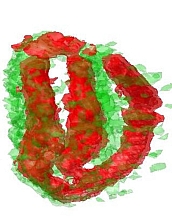News Release 06-159
Plant Studies Reveal How, Where Seeds Store Iron
Findings address worldwide iron deficiency and malnutrition

This 3-D image shows where iron (red) and manganese (green) are found in a seed.
November 2, 2006
This material is available primarily for archival purposes. Telephone numbers or other contact information may be out of date; please see current contact information at media contacts.
Biologists have learned where and how some plant seeds store iron, a valuable discovery for scientists working to improve the iron content of plants. Their research helps address the worldwide problem of iron deficiency and malnutrition in humans.
The team found that iron is stored in the developing vascular system of the seed of Arabidopsis, a model plant used in research. In particular, iron is stored in the vacuole, a plant cell's central storage site. The researchers also learned this localization depends on a protein called VIT1, known to transport iron into the vacuole.
"Iron deficiency is the most common human nutritional disorder in the world today, afflicting more than 3 billion people worldwide," said Mary Lou Guerinot, a biologist at Dartmouth College in N.H. and the principal investigator on the study. "Most of these people rely on plants for their dietary iron, but plants are not high in iron, and the limited availability of iron in the soil can limit plant growth. Our study suggests that iron storage in the vacuole is a promising, and, before now, largely unexplored target for increasing the iron content of seeds. Such nutrient-rich seeds would benefit both human health and agricultural productivity."
The findings were published online in the Nov. 2, 2006, ScienceExpress, the advance publication site for the journal Science.
The researchers combined traditional mutant analysis (turning on and off the VIT1 protein) with a powerful X-ray imaging technique to create a map of where iron is localized in the seed. Guerinot was surprised by the finding because most studies on iron storage focus on another protein called ferritin.
"This project is a wonderful example of the power of using new combinations of tools--in this case, genetics and high-resolution 3-dimensional X-ray fluorescence imaging--to understand gene function," said Jane Silverthorne, a program director in NSF's Division of Biological Infrastructure, which funded the research. "The discovery that iron localizes in specific parts of a seed opens the possibility of developing seed crops such as grains and beans with increased content of this important nutrient."
The findings reveal how essential it is to look beyond ferritin to understand how iron is stored by plants. The researchers say the stored iron in the vacuole is a key source of iron for developing seedlings. Seedlings that do not express the VIT1 protein grow poorly when iron is limited.
In addition to funding from the National Science Foundation, the study was also supported by the National Institutes of Health. The imaging was carried out at the Department of Energy's National Synchrotron Light Source at Brookhaven National Laboratory.
Other authors of the paper include Sun A Kim and Tracy Punshon, both of Dartmouth, Antonio Lanzirotti of the University of Chicago, Liangtao Li and Jerry Kaplan of the University of Utah School of Medicine, José Alonso with North Carolina State University, and Joseph Ecker with the Salk Institute for Biological Studies.
-NSF-
Media Contacts
Cheryl Dybas, NSF, (703) 292-7734, email: cdybas@nsf.gov
Sue Knapp, Dartmouth College, (603) 646-3661, email: sue.knapp@dartmouth.edu
The U.S. National Science Foundation propels the nation forward by advancing fundamental research in all fields of science and engineering. NSF supports research and people by providing facilities, instruments and funding to support their ingenuity and sustain the U.S. as a global leader in research and innovation. With a fiscal year 2023 budget of $9.5 billion, NSF funds reach all 50 states through grants to nearly 2,000 colleges, universities and institutions. Each year, NSF receives more than 40,000 competitive proposals and makes about 11,000 new awards. Those awards include support for cooperative research with industry, Arctic and Antarctic research and operations, and U.S. participation in international scientific efforts.
Connect with us online
NSF website: nsf.gov
NSF News: nsf.gov/news
For News Media: nsf.gov/news/newsroom
Statistics: nsf.gov/statistics/
Awards database: nsf.gov/awardsearch/
Follow us on social
Twitter: twitter.com/NSF
Facebook: facebook.com/US.NSF
Instagram: instagram.com/nsfgov


